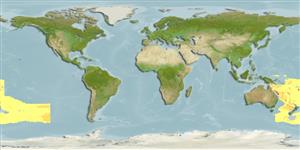Élasmobranches (requins et raies) (sharks and rays) >
Pristiophoriformes (Saw sharks) >
Pristiophoridae (Saw sharks)
Etymology: Pristiophorus: pristio-, presumably derived from prio (Gr.), to saw, but treated here as a noun (a saw); phorus, from phoreus (Gr.), bearer or carrier, referring to saw-like snout (note also that pristis is Greek for sawfish) (See ETYFish); delicatus: Latin for dainty or delicate, referring to fine, delicate rostral teeth on elongated rostrum (See ETYFish).
More on authors: Yearsley, Last & White.
Environment: milieu / climate zone / depth range / distribution range
Écologie
marin; profondeur 246 - 405 m (Ref. 76934). Tropical
Western Pacific: Australia.
Taille / Poids / Âge
Maturity: Lm ? range ? - ? cm
Max length : 62.5 cm TL mâle / non sexé; (Ref. 76934); 84.5 cm TL (female)
Description synthétique
Clés d'identification | Morphologie | Morphométrie
This small species possess the following characters: nostril to barbel origin is 3.2-3.7 times mouth to nostril; prenasal length 1.7-1.8 times the prebarbel length; preoral length 2.1-2.4 times the interdorsal space; pectoral anterior margin 1.2-1.5 times the dorsal-caudal space; dorsal caudal margin 4.4-5.0 times caudal fin depth; width of mouth 2.7-3.7 times the length spiracle; color dorsally pale to medium yellowish brown, ventrally pale whitish to yellowish; 49-55 monospondylous centra; 50-54 precaudal diplospondylous centra; 149-156 total vertebral centra (Ref. 76934).
Life cycle and mating behavior
Maturité | Reproduction | Frai | Œufs | Fécondité | Larves
Yearsley, G.K., P.R. Last and W.T. White, 2008. A new species of sawshark, Pristiophorus delicatus sp. nov. (Pristionphoriformes: Pristiophoridae), from Northeastern Australia. pp. 23-33. In P.R. Last, W.T. White and J.J. Pogonoski (eds). Descriptions of new Australian chondrichthyans. CSIRO Marine and Atmospheric Research Paper no. 22. 365 p. (Ref. 76934)
Statut dans la liste rouge de l'IUCN (Ref. 130435: Version 2024-1)
Menace pour l'homme
Harmless
Utilisations par l'homme
Outils
Articles particuliers
Télécharger en XML
Sources Internet
Estimates based on models
Preferred temperature (Ref.
123201): 8.8 - 18.9, mean 13 °C (based on 19 cells).
Phylogenetic diversity index (Ref.
82804): PD
50 = 0.5156 [Uniqueness, from 0.5 = low to 2.0 = high].
Bayesian length-weight: a=0.00389 (0.00180 - 0.00842), b=3.12 (2.94 - 3.30), in cm total length, based on all LWR estimates for this body shape (Ref.
93245).
Niveau trophique (Ref.
69278): 3.9 ±0.6 se; based on size and trophs of closest relatives
Fishing Vulnerability (Ref.
59153): Moderate to high vulnerability (54 of 100).
